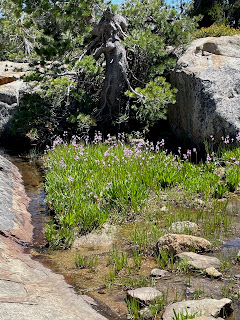Unbelievably gorgeous landscapes, swims in cold mountain lakes, rigorous hiking, challenges met and overcome, good hiking companions—everything that makes a good backpacking trip came in spades in my recent week-long trip in the Emigrant Wilderness Area, just north of Yosemite, with my friend Scott and his cousin's daughter, Erin.
 |
| Scott and Erin, my tall, long-legged hiking partners |
Scott, a Sierra Club outings leader, was looking at the route we took as a potential Sierra Club trip. When I asked, as we were walking out, how he would rate it for difficulty, he said, "A solid 4." (The Sierra Club's "most difficult" rating is 5.)
I whole-heartedly agree. The trail was so steep in places I thought I just couldn't haul myself—and my pack—up another two-foot-high rock step in the long, beautiful, built-in-granite, rock staircases. At one point, I thought, "Diana, you're 80 years old. What do you think you're doing?" But on I went and on I went and on I went, and I did every step of the trail and loved it all. Many times I rounded a curve to find Scott and Erin waiting for me. Seeing me, satisfied that I was coming, they turned around and kept on hiking. I followed without stopping.
We camped in glorious places. My favorite was on the granite slabs above insuperably beautiful Lake Lertora, achieved on a "black diamond, singletrack trail with a hard overall physical rating." (Agreed!) That night we watched the sunset stripe the sky and the lake with pinks and oranges; the next morning I got up at 6:00 for a swim. Yes, it was cold (7877-foot altitude), but it was so beautiful I couldn't leave the water. I swam around a large granite-based island with trees and flowers before finally pulling myself to shore. It was, Erin estimated, a 40-minute swim.
I had a swim every morning. At one campsite, while Scott was trying to catch a trout he could see holding steady in the current, I swam across the river and back. As the trout never bit, we dubbed the campsite Camp Elusive.
There were numerous stream crossings. Each time, I watched Erin cross first to see how deep the water was. Three or four times the water was so deep I took off my shorts to cross in my underwear and let Scott carry my pack.
If the current was strong Erin carried my shoes so I could use both hands unencumbered on my hiking poles. Do you see what I mean? Great hiking companions.
 |
| Crossing Wood Lake |
If the current was strong Erin carried my shoes so I could use both hands unencumbered on my hiking poles. Do you see what I mean? Great hiking companions.
 |
| Scott filling water bottles at a stream crossing |
Day after day we took to the trail, climbing over logs, up steep stone staircases, through mosquito-infested marshes, across steep snowfields, and, always, through the stunning landscape of the high Sierra. One day, on an unmaintained trail, Scott's phone with its GPS died, so we had to do some trail-hunting. We didn't get to our destination that long, difficult day till 6:00 that evening. When we got there—Gem Lake—the bugs were awful. Actually, the whole trip was marked with unending mosquitoes. We wore mosquito nets over our hats most of the time and kept any exposed limbs well lubricated with bug repellent.
But in the high Sierra, if you have mosquitoes in June, you also have flowers. l was in seventh heaven with the spreads of pale lavender shooting stars,
bright magenta penstemon, heather almost the same color, and spreads of pink pussy paws, yellow brodiaea, and gorgeous clumps of pink and white creeping phlox among the white granite.
bright magenta penstemon, heather almost the same color, and spreads of pink pussy paws, yellow brodiaea, and gorgeous clumps of pink and white creeping phlox among the white granite.
Each of us had brought dinner for all of us for one night. Erin's was best—rice with three tins of mackerel, rich and fulfilling and impressively heavy to carry. I wished I had brought more cream cheese to go with the pasta I served, but, unlike Erin, I was considering the weight of my pack.
One night we looked at a campsite in the trees by the river, but it had an animal hole, front door and back door, which we figured was a fox's, so we camped instead on the rocks above the river. Sure enough, that night I heard the fox bark down there where we had thought to camp.
At Lake Lertora we were entertained for hours by nuthatches and woodpeckers flying in and out of holes in a tree facing our campsite.
We saw an occasional marmot. Lots of trout, a pileated woodpecker. No bears or deer.
 |
Have I talked you into hiking into the Emigrant Wilderness from Crabtree Trailhead? It ain't easy! But it's OMG gorgeous.

























